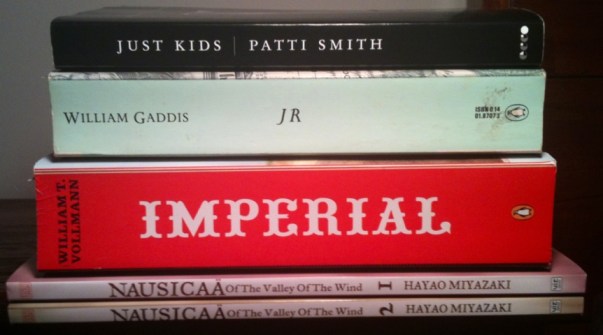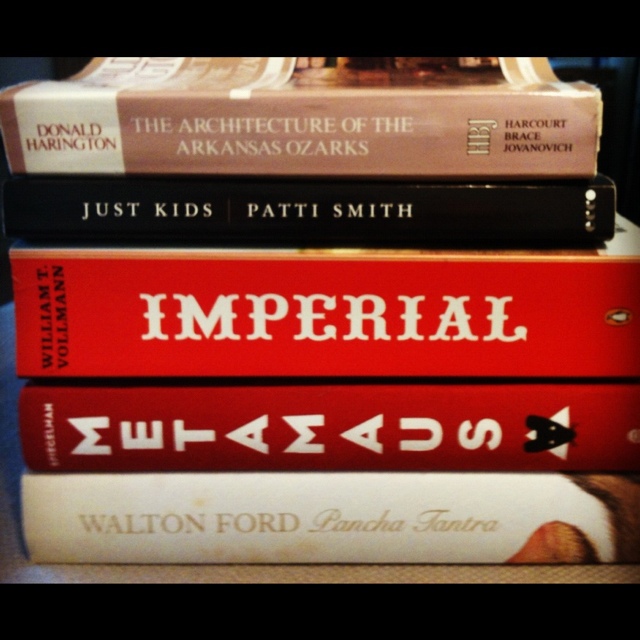Last month, I listened to audiobook versions of the first three novels in George R. R. Martin’s A Song of Ice and Fire Series—A Game of Thrones, A Clash of Kings, and A Storm of Swords. These are long audiobooks, thirty or forty hours each, and they engrossed me, held me hostage even. Martin’s plot is a page turner, a beautiful balance of cliffhangers, mystery, intrigue, and action telegraphed in bristling, energetic prose. Actor Roy Dotrice turns in an amazing performance here, differentiating dozens of characters and communicating the emotional depth of Martin’s novel. If you’ve had a passing interest in Martin’s ASOIAF and you like audiobooks, you might be interested in checking these out.
So what are these books about?
I’ve read and heard Martin’s works offhandedly compared to J. R. R. Tolkien’s Lord of the Rings series, and it’s true that there are similarities, both superficial and structural : Both engage an epic scope; both are very long, comprising multiple volumes; both employ multiple character perspectives; both share a love for music, philology, and history; both are about war; both are very well written. Perhaps the central comparison is that both ASOIAF and LOTR are works of world invention, which is to say that these books are set in respective worlds that are not our world, worlds that have been, for better or worse, ghettoized as “fantasy” worlds. Another way of comparing these series is to point out then that one is more likely to find them in the “Fantasy” section than in, say, “Literary Fiction.”
It’s true that both LOTR and ASOIAF contain the signifying tropes of fantasy fiction: thrones, kings, swords. Magic. Dragons and shit.
In LOTR, magic is still very much alive in Middle Earth. Indeed, the plot of the book revolves around destroying a magical ring to defeat a foe of pure evil and restore the true king to his true throne; a wizard orchestrates these events (dying and being reborn in the process). At the end of the trilogy, the elves leave Middle Earth, sailing off into the sunset to live happily ever after, perhaps taking much of the world’s magic with them, leaving the humans to perhaps evolve as the dominant beings of that world. There’s a teleological neatness here, a reassurance of ideal order.
LOTR is all about the restoration of true identity and the return home after the great journey. I’ve run into readers who’ve expressed frustration with the end of The Return of the King; the book’s ending seems stretched out, elongated. After epic battle, there’s something deflationary about the hobbits’ returning to the Shire. But this is one of the major points of Tolkien’s process: the heroes must return to the domestic sphere, authority conferred upon them by their dramatic encounters with the sublime. They will now put their own community back to order.
Martin’s book could not be more opposite. While LOTR is about restoring order and expunging the polluting evil (from the swarthy south and the dark east) from a pure, now stable realm, ASOIAF explores the disruption, dissolution, and fragmentation of a continent in the midst of civil war. Tolkien wrote of war too, with bitter darkness, to be sure, but his epical, heroic mode makes little room for depicting the visceral horror of war. Nor does he concern himself with the Machiavellian intrigue that harnesses and exploits the rage of war. Tolkien’s characters are motivated by pure, intrinsic, and very black-or-white ideals; characters without these ideals (like Gollum or Denethor) are presented as insane.
In contrast, Martin’s plot catalogs the constantly shifting allegiances (both intra- and inter-family), betrayals, alliances, and upstarts that repeatedly throw his characters into new roles, new stations, new names. Martin’s camera is also keenly attuned to the Darwinian struggle that underwrites all existence, a struggle that war dramatizes. Martin’s books are, quite frankly, some of the most violent stuff I’ve ever read, full of beheading, mutilation, disemboweling, rape, and murder. He also takes great pains to show the way that war impoverishes the most vulnerable of people, taking food out of their mouths and obliterating their families. Martin’s engagement with political machinations and radical violence put his books closer to Blood Meridian or Wolf Hall, in many ways, than to standard fantasy fare.
To be clear, I am in no way arguing that LOTR, one of my favorite books of all time, is “standard fantasy fare.” LOTR obviously established many of the tropes and codified the themes and archetypes for the contemporary publishing genre that we call “fantasy.” We can also all recognize that much of what comes out of this genre (Robert Jordan comes to mind) is vile, flat, affectless dreck. Reductionist attitudes and vague misconceptions still keep some readers from recognizing that LOTR is a fully-realized work of meaningful, historically and artistically important literature. Similar attitudes and misconceptions might keep readers away—unnecessarily—from ASOIAF, a work that, like LOTR before it, invents a new idiom in storytelling. ASOIAF complicates claims of narrative truth, critiques patriarchy, reconceives what constitutes family, disrupts traditional archetypes, destabilizes ideal identity, decenters moral authority, and subverts narratological expectation. In short, Martin may have given us the definitive postmodern “fantasy” novel.
Martin layers these themes through his strange (and estranged) characters, shifting between them in point of view chapters written in the free-indirect style of late modernism. LOTR codifies an allegorical good vs. evil narrative, one that rests on the destruction of a magical object and the restoration of a “true” king. The narrative of LOTR is thus direct, teleological, and closed to outside narrativization. Put another way, we’re not getting the orc’s point of view (although that has been done). Martin’s narrative rejects the notion of a stable absolute truth, authority, or even identity. A civil war drives his narrative, a bloody competition between self-proclaimed kings, whose war machines dramatize Darwinian competition; this theme doubles in the Oedipal infighting and conflicts between and within the great Houses of Westeros, Martin’s world.
There are a few “traditional” epic heroes in Martin’s work, or at least the types of characters one might expect a fantasy adventure to focus on—dashing knights, regal kings, wise old men. Instead of focusing on these people and their hopes and fears and desires, Martin trains his camera on characters marginalized, outcast, or outright threatened by the patriarchy: a dwarf, an little girl, a mother, a bastard with no rights of inheritance, a crippled boy, an exiled teenage girl who must create her new identity piecemeal . . . As a point of contrast to these characters, who find their circumstances constantly inverted and disrupted, in the first book, A Game of Thrones, Martin allows his POV chapters to hover around the consciousness (and rigid conscience) of Lord Eddard Stark (“Ned”), arguably the closest thing the series has to an initial hero (uh, BIG SPOILER ahead; skip the rest of this paragraph to avoid it). Ned’s worldview is rigid and clear, tempered by a love and duty for both his family and the people he has sworn to protect. He is a good man, but his goodness, his love and his righteousness are not sentimental. In a key opening scene, Ned carries out the execution of a man who has broken an oath. As Lord, it is his duty to condemn the man, but Ned chooses to behead the man himself, not because he relishes bloodshed but because he finds bloodshed revolting—in short, he must remind himself at all times of life’s cost. In an ironic plot twist, Ned is beheaded himself in an act of betrayal; the moment is shocking. It signifies, on one hand, Martin severing his book’s narrative from traditional ideals of honor and justice; narratologically, it removes its characters from the protection of ideal and honor. Ned’s death is not a death of self-sacrifice. It is not heroic, nor does it posit apotheosis or rebirth. It is simply grim, ugly, and violent. The violence of war does not follow the narratives that we might like to subscribe to.
Although Martin’s books are gritty and concrete, with characters motivated by ever-shifting tendrils of intrigue, they nevertheless contain metaphysical elements. However, the magical parts of ASOIAF are slight, obscured to most of its characters who treat the idea of magic and magical beings with the same skepticism and cynicism that we find in our own world. If LOTR shows a world where magic is slowly leaving the world to make way for a new age, ASOIAF describes a world where the metaphysical detritus of the past begins to improbably thaw and return. These small but important magical eruptions are set against the the political infighting and civil war of Westeros. The great arc of A Series of Ice and Fire, which will reportedly run to seven books, seems to point to a larger conflict between the humans and a strange group of beings, significantly named The Others.
As much as I enjoyed and admire Martin’s first three books, I’m unsure if I will continue the series. I consumed Thrones, Kings, and Swords with a greedy gusto—even when he killed off characters I’d grown to care about, or otherwise disrupted my expectations. These narratives are rich, complex, and engrossing. Martin has a keen ear for Medieval dialogue, his mystery plots demand engagement, and life-or-death drama evokes adventure and invokes pathos without ever dipping into crudity or sentimentality. What’s most intriguing though is Martin’s analysis of war and politics; ASOIAF, through its many viewpoints, evaluates a world in turmoil with a precise intelligence and surprising wisdom. So, why do I say that I’m not sure if I’ll keep going?
Simply put, I started the fourth book, A Feast for Crows, and it’s just bloody awful. Could be that I just can’t stand the narration of John Lee, who seems to be channeling Christopher Lee doing Vincent Price doing Edgar Allan Poe. I hated Lee’s narration of China Miéville’s novel Kraken so much that I abandoned it. Roy Dotrice did a marvelous job bringing spirit to Martin’s novels; Lee’s sonorous sing-song is an amorphous mess. I was taken aback, to be sure, but I also wanted very much to know what the hell happened to my favorite characters after Swords. The mp3s of the book are titled after the character that they follow; a quick scan followed by some basic research revealed that this fourth book wasn’t going to pick up much about the fates of the characters I’m interested in. Scanning a few reviews of Crows, I see that it was not well-received, even by (especially by) Martin’s hardcore fans. The consensus seems to be that the book sprawls too much, splashes over the early boundaries Martin had set for himself. Teleological narratives like Lord of the Rings guarantee tidy resolution for their audiences; Martin’s post-modern narrative seems to insist, even before its half-way mark, that even an archetypal conclusion will be impossible. So I’ll follow his lead, and leave my review open-ended. I’d love to hear from any readers who have suggestions about the fourth and fifth books of A Song of Ice and Fire.
UPDATE (3 Jan 2013):
I ended up reading the fourth/fifth ones.
In the comments section, Jeff Schwaner offers an excellent description of Martin’s project:
Nothing comes to an end in Martin’s book. Fortunes continue to change, that big wheel keeps turning and crushes a few more characters underfoot and, as Melville writes, “then all collapsed, and the great shroud of the sea rolled on as it rolled five thousand years ago.” Even the most dramatic stories sink and lose their primacy, replaced by the newest wave, which is only the shape of a thing and not a thing itself. Which is, at least I think, part of Martin’s point. Longest story short, it is definitely worth reading the rest.
Martin clearly intends to disrupt (and therefore dissatisfy) our expectations about what a narrative should do. However, there’s only so much of that that I think can stick. Once a reader figures out what Martin’s doing, the project gets rather dull (fourth book in particular)—we’re repeatedly asked to care about characters that we can expect to die at any second; Martin seems more interested in describing clothes and food and drink than getting down to the schemes and mysteries that make the first three books so engaging.
I understand the fantasy he’s disrupting in deconstructive terms: authority (its metonymy in crowns, thrones, swords, armies, dragons, etc.) is always displaced; there is no conclusive “ending,” despite what we are asked to believe (Return of the Queen; Winter Is Coming; White Walkers Are Coming; New Gods, etc.). The story started in media res and will end in media res.For me, this is engaging from a theoretical standpoint, but as a reader (and a reader who wants to read, like, *everything*) so much of ASOIAF comes across as the act of a plate-spinner, a bag of entertaining tricks that distract you from the fact that there’s nothing beyond the act itself.
But I’ll almost undoubtedly read the sixth one if he ever finishes it.


 (You saw these last year, but they are still good. By
(You saw these last year, but they are still good. By .jpg!Large.jpg)





